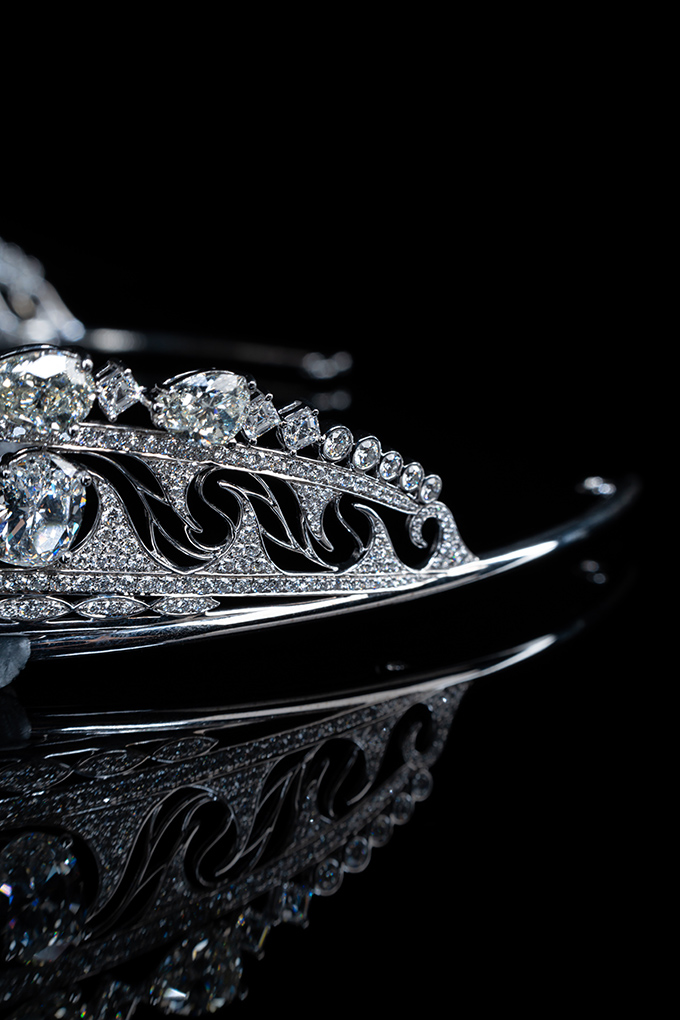Tiaras are fantastical things. They’re wondrous: the stuff of princesses and fairytales. Which is part of the fascination when a royal wedding happens and tiaras—the real life stuff—leave the safes and be worn. The pomp and circumstance brings out levels of opulence and ceremony that are rare and uncommon. The wedding that everyone has had their eyes on recently was the union between Prince Abdul Mateen of Brunei to Anisha Rosnah. Amid the all the finery of the 10-day-long procession, which ran from 7 to 16 January, was a little piece of Singapore that drew the eyes of the world. On the eighth day, for the Royal Bersanding Ceremony and Royal Procession which are the highlights of the wedding, Princess Anisha Rosnah wore a diamond tiara that was created by Singapore jewellers Flower Diamond.
The tiara is certainly beautiful enough to warrant fascination. Crafted entirely in 18-carat white gold, and festooned with 838 diamonds, it is a sight to behold. But the process of crafting and making a contemporary tiara for royalty is normally shrouded in privacy and secrecy. In fact, the royal family of Brunei almost never names the jewellers who make their pieces. Belinda Chua, the founder of Flower Diamond, sought permission on this occasion to release information about the tiara and received a happy surprise in the affirmative. According to the brand, which was founded in 1996, it has received commissions for over 20 years by the Brunei royal family to design and set jewellery.
This royal tiara is a relatively new one, having only made its second appearance with the recent wedding. It was originally commissioned by Princess Azemah, the sister of Prince Mateen, for her wedding in January 2023. Her creative brief was surprisingly straightforward for something so symbolic and ornate. “Something simple, nothing too high or short, and something with a modern and lighter shape,” recounts Sabrina Ho, who manages the marketing and communications for Flower Diamond. The most specific detail was simply that the large pear- and oval-cut diamonds that feature in the tiara, loose stones already in the possession of the royal family, be worked and set into the final creation.
The result is a rather airy and delicate design: a slender frame that’s fully set with single rows of round brilliant and square diamonds; 13 large oval diamonds that radiate from a central arrangement, each of them mounted and connected with delicate curling gold filigree; and 16 ample pear-cut diamonds at the top, their points aimed at the centre and each linked by a square diamond, that trace a line towards an oval diamond that takes the crowning position at the top.
When commissioning a piece with as many as 838 diamonds—all of which are, at minimum, VVS clarity and which total over 132 carats in weight—the bulk of the challenge is actually sourcing the right stones. Simply finding and accumulating the gemstones to match in a creation like this—especially for the biggest, most obvious main stones—can take years. But because the main diamonds were already accounted for, the entire process from start to finish took Flower Diamond just eight months.




The brand’s creative director Roslind Ng presented Princess Azemah with three sketches drawn precisely to scale. These sketches, being as important as they are, took Ng a month to prepare, as compared to the usual week that she needs for bespoke orders. Having worked with the royal family for over two decades, Ng was fairly familiar with their tastes. The brand cites a preference by them for curved, wavy designs over sharp, pointed edges.
To enhance the modernity of the design and to create a floating effect, Ng used glossy mirror-polished finishes, fine gold filigree details, and uncomplicated prong settings. There was also a question of using either a pointed pear-cut or a rounded oval diamond to be the centrepiece stone at the top of the tiara. Ng made the salient decision to use an oval stone, which gives the tiara a softer and more modern look that’s enhanced by the pear-, princess- and round brilliant-cut diamonds that frame it on the sides. And to ensure the tiara was perfectly symmetrical, Ng began her design process sketching just one side and later mirroring it exactly.

After Princess Azemah had made her choice of the proposed designs, two prototypes were cast in brass for fittings to ensure a perfect fit. Once the fit had been adjusted, a final version was cast in gold and the diamonds finally set and mounted in Singapore. It was then delivered, and made its debut at Princess Azemah’s wedding.
As for the choice of this particular tiara for Prince Mateen’s and Princess Anisha’s wedding, it’s said that the Prince was the one who chose this design, originally worn by his sister, for his bride. All it took was some careful adjustments to perfect the fit of the headpiece for Princess Anisha. Stylistically, this lighter, modern design was a faultless choice for the young royal couple—possibly a symbolic one, too, of the royal siblings’ fondness for each other. And as a piece worn before by Princess Azemah, it perfectly fulfilled the time-honoured adage of a bride wearing something borrowed from a happy, married couple to bring luck.





